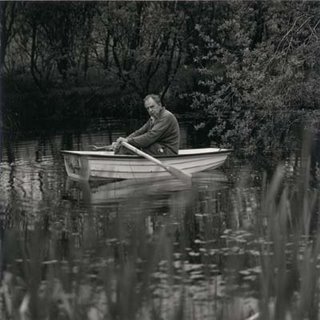
Ian Hamilton Finlay, 1925 – 2006.
What to call Finlay? Poet, Concrete poet, conceptual artist, gardener? Conservative? Revolutionary? Radical? Fascist? He posed some of the problems of the last century as eloquently and starkly as any poet or artist of our moment.
I never met Finlay, & my first-hand encounters with his work were few – a sundial in downtown Biggar, the town where MacDiarmid spent his declining years; a broken stone sculpture of the Saint-Just aphorism, "The Present Order is the Disorder of the Future" (in Italian), at the Cheekwood Gardens in Nashville – but his work has obsessed me as much as that of any poet alive.
Jonathan Williams made much of the early Finlay's fondness for the "wee" and homespun. Such fondness could be put to the service of deflation, however, as in the Fifth "Orkney Lyric," "Mansie Considers the Sea in th Manner of Hugh MacDiarmid":
The sea, I think, is lazy,His Poor.Old.Tired.Horse. was the most important journal of concrete poetry in the English-speaking world, his Little Sparta the most important poet's garden since Alexander Pope's. It is going too far to call Little Sparta, as the writer for the Times does, a "shrine to pacifism," for early & late Finlay evinced a grim fascination with the violence inherent to revolution, the echoes of pre-Sokratic imagery in modern weaponry. Saint-Just – Barrère: "He spoke like an axe" – was Finlay's patron saint; Apollo his deity, transformed to "Apollon Terroriste"; the aircraft carrier was, in Empedokles' words, "The Divided Meadows of Aphrodite."
It just obeys the moon
–All the same I remember what Engels said:
'Freedom is the consciousness of necessity'.

No comments:
Post a Comment